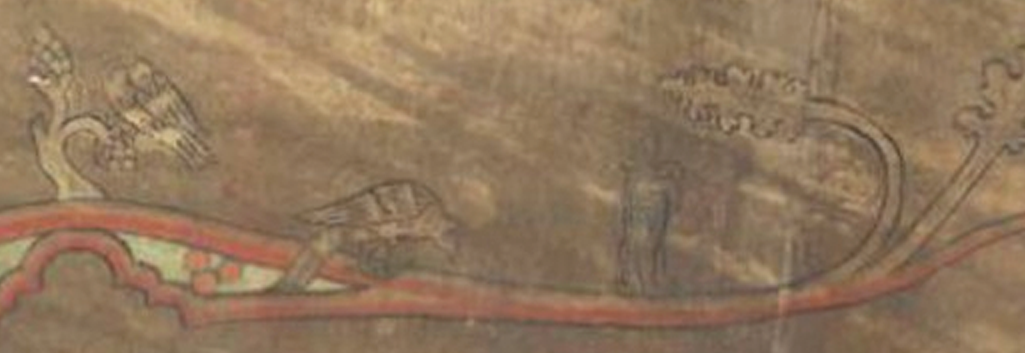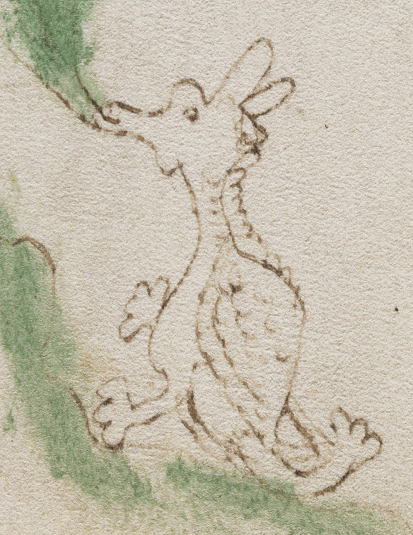 It’s difficult to make sense of the little critter by the plant on folio 25v. It has elements of a camel, a giraffe, and the dragons that inhabit the pages of medieval manuscripts. What is it and what is it doing? It looks like it’s nibbling on the leaf but it’s also been suggested that it might be smelling the leaf.
It’s difficult to make sense of the little critter by the plant on folio 25v. It has elements of a camel, a giraffe, and the dragons that inhabit the pages of medieval manuscripts. What is it and what is it doing? It looks like it’s nibbling on the leaf but it’s also been suggested that it might be smelling the leaf.
Nothing about it is entirely clear. Is that a mane on its neck? Is the arm-like appendage on the back a tail? Are the odd extra lines near the tail an attempt at drawing wings? Is the texture on the back a shell? a hump? or simply a different texture?
The entire drawing has a tentative not-sure-how-to-draw-it feeling.
If the hump is intended to be a shell, then perhaps the critter is a tarask, a mythical creature tamed by St. Margaret. Or maybe it’s a generic dragon, or some roughly-drawn animal with a linguistic connection to the plant.
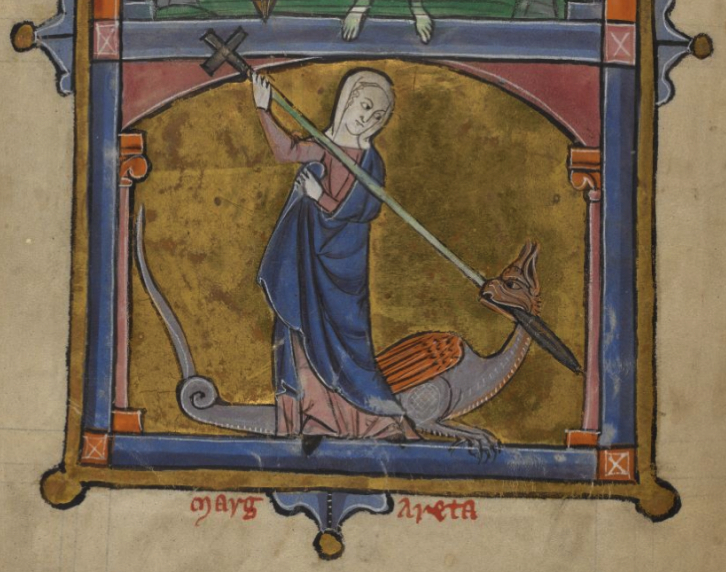
The Tarask tamed by St. Margaret has been drawn in many forms, from a six-legged turtle-monster to a two-legged basilisk-like dragon. [BL Additional 21926]
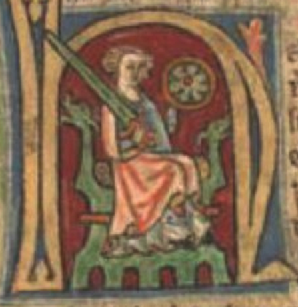 I considered many explanations for the hump but it never occurred to me, until I saw this image on the right, that the differently textured back might be a cushion, like those on dragon thrones, chairs used by nobility that were embellished with sculpted lions or dragons. The cushions were made of natural materials: leathers, furs, sometimes sheepskin pelts, bumpy like the critter’s back. I don’t think this is the most likely explanation for a critter on a plant page, but I don’t like to rule out possibilities for questions that haven’t yet been answered.
I considered many explanations for the hump but it never occurred to me, until I saw this image on the right, that the differently textured back might be a cushion, like those on dragon thrones, chairs used by nobility that were embellished with sculpted lions or dragons. The cushions were made of natural materials: leathers, furs, sometimes sheepskin pelts, bumpy like the critter’s back. I don’t think this is the most likely explanation for a critter on a plant page, but I don’t like to rule out possibilities for questions that haven’t yet been answered.
The tail of the critter is odd too, it’s almost like an extra leg or arm, with finger- or paw-like appendages that aren’t quite as flower-like as most dragons with “flower tails”. They are rounder and less defined. The manuscript with the dragon throne has a number of two-legged creatures, and flower embellishments that have this rounded aspect (which may be coincidental, but I decided to include them for those who are interested):
Whatever the creature is, it’s not hard to find various dragon-like critters that are similar, with ears, two legs, and something like a tail, but is it possible to connect them to a manuscript that is similar to the VMS in other ways?
The Short-Legged Men

The proportions of the figures in Pal. Germ 794 (second left) are common to many manuscripts. Those in the Ebersberg manuscript (left) are a little longer in the legs than usual. The shortened legs and larger heads of the VMS figures shown on the right are somewhat uncommon. Note the similarity in the woodsman’s hat and tunic to that of the VMS archer.
I’m sure I’m not the only one who has noticed that some of the male figures in the VMS have short legs in proportion to their bodies. This is especially apparent in the images of Gemini and Sagittarius and is not a common way to draw them. When I searched for medieval drawings of short-legged men, I found a number of examples, but they were definitely in the minority. The VMS females also have fairly large heads, but their legs aren’t shortened quite as much as the men.
Perhaps the men are drawn this way because the space within the circles is constrained, which makes it difficult to fit the legs, but that wouldn’t explain why the heads are quite large. If the VMS illustrator was male, was he drawing men in proportions similar to his own?
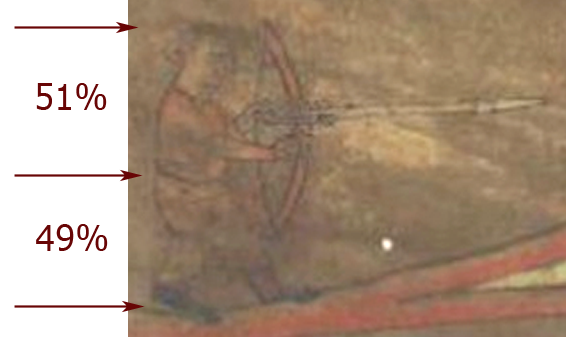 What about the figures in the manuscript with the dragon throne shown above?
What about the figures in the manuscript with the dragon throne shown above?
There aren’t many human figures who are standing—the imagery is mainly dragons, embellishments, and seated figures—but there is an archer whose proportions are similar to those of the VMS men.
Those Oddball Grain-Trees
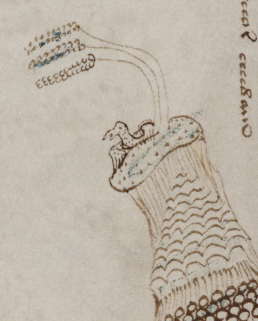 On folio 86v there is an image of a bird, perched on the ground or in a nest at the top of a tor with three odd tree-like structures bending over it like grain blowing in the wind. Medieval trees were drawn in strange and imaginative ways, but it’s hard to find parallels to tree-like plants that look like grain. Even so, this one caught my eye in the manuscript with the dragon-throne. It’s not a direct parallel, but it did include some similar elements. There are birds and, to the right, three botanical embellishments that have the proportions of trees, with narrow leaves that suggest something smaller.
On folio 86v there is an image of a bird, perched on the ground or in a nest at the top of a tor with three odd tree-like structures bending over it like grain blowing in the wind. Medieval trees were drawn in strange and imaginative ways, but it’s hard to find parallels to tree-like plants that look like grain. Even so, this one caught my eye in the manuscript with the dragon-throne. It’s not a direct parallel, but it did include some similar elements. There are birds and, to the right, three botanical embellishments that have the proportions of trees, with narrow leaves that suggest something smaller.
Summary
Most of the examples above (except for St. Margaret and the panel of proportions) are from a 14th-century Icelandic miscellany written in old Norwegian (AM 226). The content and the images are not directly comparable to the VMS, but in overall tone and style, there is something about them that makes one want to look twice. The shapes of the dragons, the rounded, simple flower-tail embellishments, the proportions of the archer, and the marginal drawing with the birds are not uncommon or hard to find when taken individually, but it’s difficult to find all these elements together in one volume.
Whether it shares a cultural kinship with the VMS or it’s a coincidence, I don’t know, but I thought it interesting enough to note.
J.K. Petersen
© Copyright 2017 J.K. Petersen, All Rights Reserved


